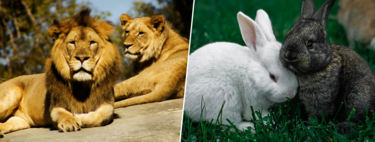A few days ago the case of a family that reported how, after save a trapped fox On their land, this had become a regular visitor to which they fed and protected.
Foxes are wild animals but in many contexts, even in densely populated areas, these mammals cohabit with our species. This implies a certain parallel with our idea about how we domesticate some of the animal species that now live with us, especially animals that live in our homes such as dogs and cats.
We can then ask some key questions, such as whether possible Domesticate these animalsor even if we will not have begun to do it with this cohabitation. The brief answer to both questions may be “yes”, but of course, there are important details to take into account.
To answer the first question in more detail, we have to go back in time, back in 1959, and more specifically to the Soviet Union. But before, a little context.
Foxes (Fox) They are a genre of canids, which makes them not very distant relatives of dogs and wolves. We distinguish a dozen fox species, among which the common fox or red fox stands out (Fox Fox), The species that is surely more familiar to us, which inhabits a huge diversity of ecosystems in Eurasia and North America, but can also be found in other regions of the globe.
Returning to the USSR of the late 50s, the great domestication experiment of the fox was devised by Dmitri Belyaev and driven by Lyudmila Trutboth experts in Soviet genetics. These researchers wanted to know if the selective crossing of the most meek specimens of the species could lead to the appearance of the so -called “domestication syndrome”, that is, the tendency to accumulate certain characteristic features: flaccid ears, youth facial features or mottled fur, among others.
Thus they could prove that these features could effectively associate with the domestication process, as would have happened in other species. The second hypothesis was to study if these external features were related to genes associated with calm and more “friendly” behaviors towards humans.

Generation after generation The team was selecting the most meek specimens to continue with an experiment that survived even the fall of the Soviet Union. An experiment that lasted during more than six decades. But 15 generations were enough to obtain first results. By the 1970s the team had already achieved meek specimens, such as Pushinka, capable of living with those responsible for the experiment.
The experiment that survived even the fall of the Soviet Union. Belyaev died in the mid -1980s and Trut less than a year ago, in October 2024. The descendants of their foxes still last. Russian domesticated fox, Siberia fox or domesticated silver fox, are some of the names by which this subspecies of the fox is known, also by its “scientific name” Fox foxes f. friend.
Are we doing it again?
It is possible that Trut foxes are not the only vulpids in undertaking the path of domesticon. In Europe and other places in the world, the populations of foxes living in suburban and even fully urban areas are not uncommon. The possibility that that of these populations is a case of self -controlling has also attracted the interest of some scientists.
According to the author Virginia Morell for the magazine a few years ago Sciencethis was the case of Kevin Parsons. Intrigued by foxes that was in the streets From the city where he worked, Glasgow, this Canadian decided to go to the collection of foxes of the national museums of Scotland.
The institution had a collection of about 1,500 skulls obtained in the 1970s, when the city of London and surrounding areas carried out a hunting campaign to reduce the number of foxes in the environment. The bone remains belonged therefore to animals hunted both in rural and urban environments.
Parsons photographed and studied more than a hundred of these skulls, identifying their features in search of clues about domestication syndrome. And found them: the “urban foxes” presented shorter and more wide snouts, and smaller brains than hunted in rural environments. The details about his study were published in 2020 in an article in the magazine Proceedings of the Royal Society B: Biological Sciences.
The implications of domesticating a wild animal, of creating new species or subspecies perhaps within a period not too long, are complex, with different ethical and ecological variables to consider. Do this With just being aware It is problematic since we cannot even take the precautionary measures necessary to avoid inconveniences.
That is why the coexistence between foxes and humans has a dark side, not because of particular cases such as the one we mentioned at the beginning of the article but as a consequence of the urban life modes. There is therefore not much that we can do, but knowing the phenomenon may help avoid the possible negative consequences that it could have.
In WorldOfSoftware | Four years ago someone ran over a dog in Brazil: today we know that it was not a dog or should have existed
Image | Brett Jordan











